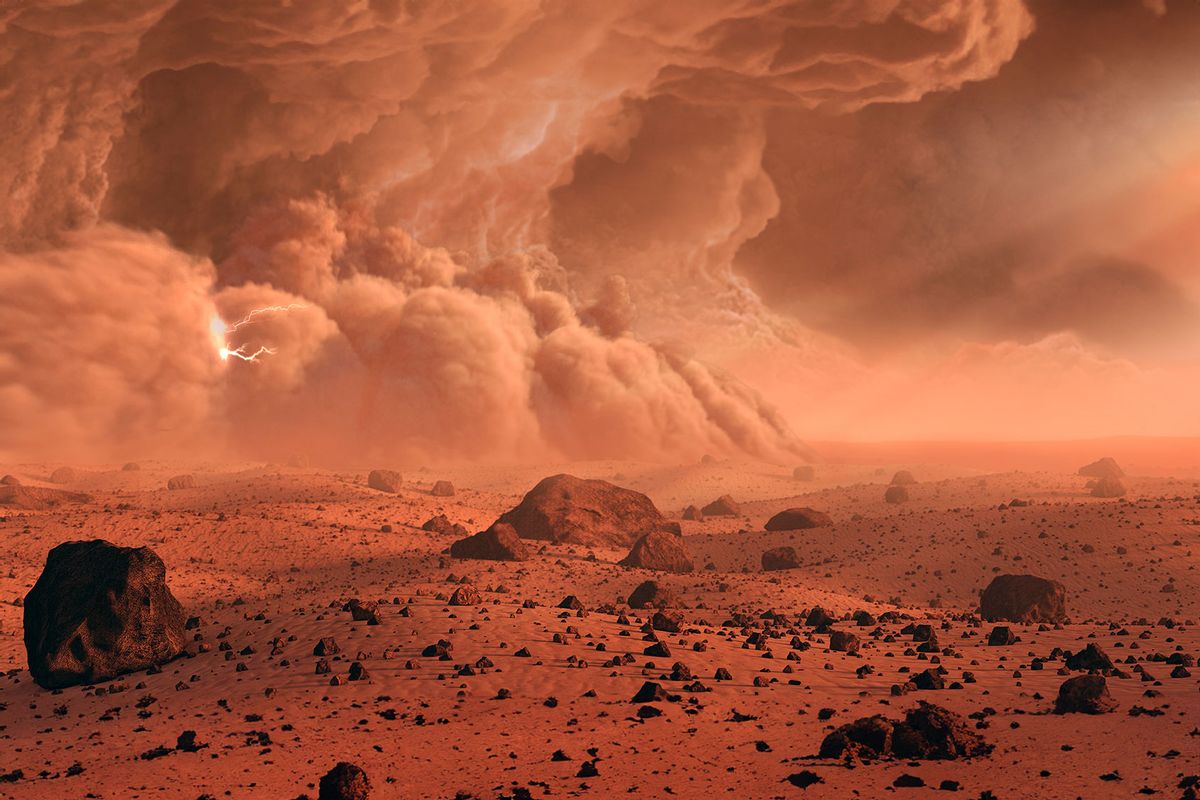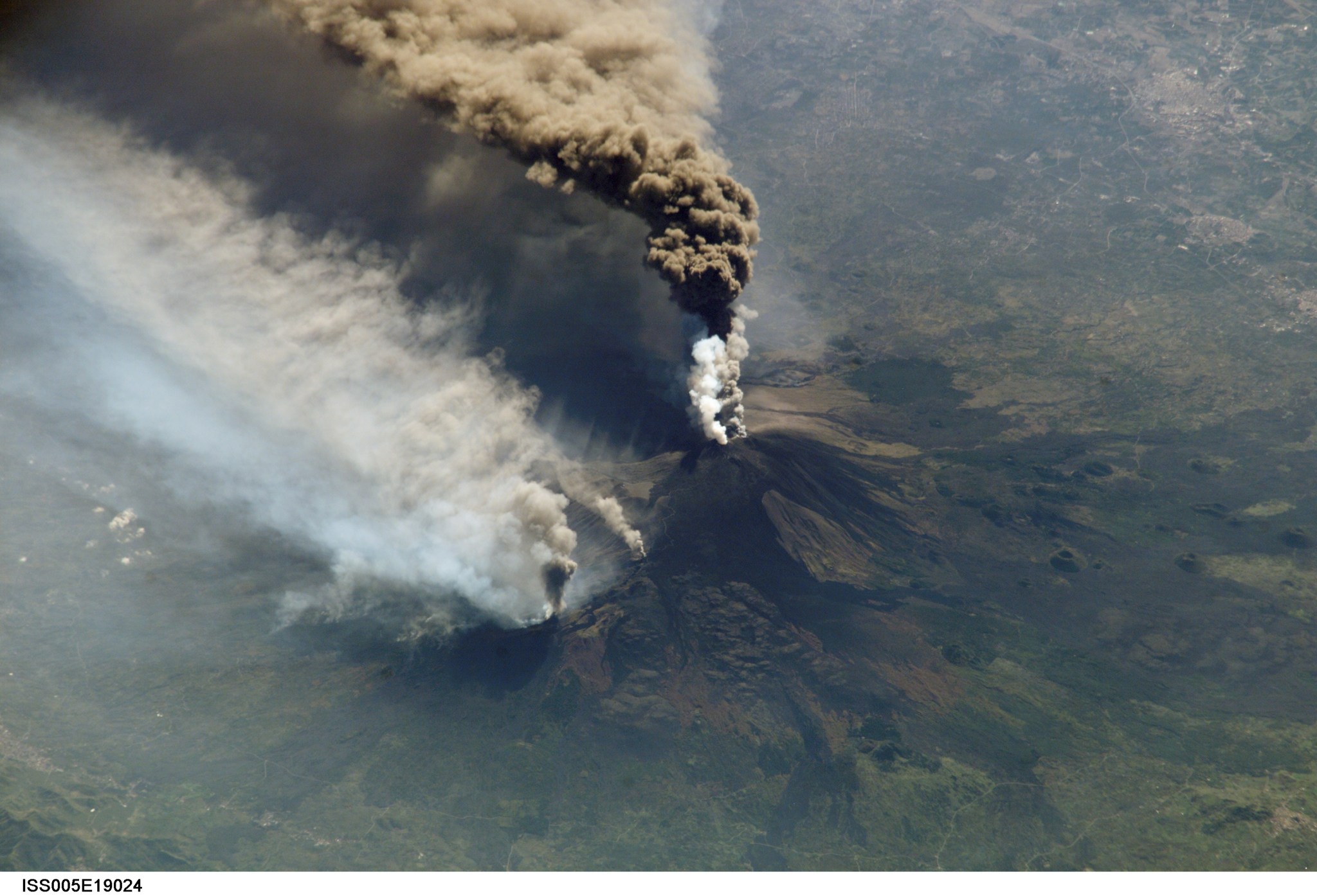The National Science Foundation takes a step (just one) toward an “extremely large telescope.”

By Dennis Overbye
March 8, 2024
The United States should commit $1.6 billion to building an “extremely large telescope” that would vault American astronomy into a new era, according to the National Science Board, which advises the National Science Foundation.
In a statement on Feb. 27, the board gave the foundation until May to decide how to choose between two competing proposals for the telescope. The announcement came as a relief to American astronomers, who have been fretting about losing ground to their European colleagues in the quest to examine the heavens with bigger and better telescopes.
But which of the two telescopes will be built — and the fate of the dreaming and the billions of dollars’ worth of time and technology invested already — remains an open question. Many astronomers had hoped that the foundation, the traditional financier of national observatories, would find a way to invest in both projects.
The two projects are the Giant Magellan Telescope at Las Campanas in Chile and the Thirty Meter Telescope, possibly destined for Mauna Kea on the island of Hawaii, also known as the Big Island. Both would be larger and more powerful than any telescope currently on Earth or in space. Each is expected to cost some $3 billion or more, and less than half the projected cost has been raised so far by the international collaborations backing them.
In an announcement circulating among astronomers, the board said that funding even one telescope at the price point of $1.6 billion would take up most of the N.S.F.’s typical budget for construction.
“Moreover, the priorities of the astronomy and astrophysics community must be considered in the broader context of the high-priority, high-impact projects for the many disciplines that N.S.F. supports,” the board said in its statement last week.
So far, astronomers with a stake in the outcome have been careful to note that Congress, as well as the White House and the science foundation, would eventually all have their say.
“This is a marathon, not a sprint,” said Robert Kirshner, director of the Thirty Meter Telescope International Observatory and a former member of the Giant Magellan team. He added that he was hopeful that both telescopes could go forward.
Michael Turner, an emeritus cosmologist at the University of Chicago and former assistant director for mathematical and physical sciences for the N.S.F., called the recent development “excellent news for U.S. astronomy and saw “a realistic path forward” for an extremely large telescope.
“Before you know it, the telescope will be dazzling us with images of exoplanets and the early universe,” he said. “Should it have happened faster? Of course, but that is history. Full speed ahead, eyes on the future!”
Wendy Freedman, a cosmologist at the University of Chicago who led the Giant Magellan project in its first decade, said in an email: “I am very pleased that the N.S.B. has decided to fund an E.L.T. I think that the worst outcome would have been not to fund any E.L.T. at all; that would have been a tragedy! Realistically (and unfortunately), there is not a budget for two. But an E.L.T. is critical for the future of U.S. astronomy.”
She added, “So I am very relieved.”
Robert Shelton, president of the Giant Magellan collaboration, said: “We respect the National Science Board’s recommendation to the National Science Foundation and remain committed to working closely with the N.S.F. and the astronomical community to ensure the successful realization” of an extremely large telescope, “which will enable cutting-edge research and discoveries for years to come.”
But Richard Ellis, an astrophysicist at University College London who was one of the early leaders of the Thirty Meter Telescope project, told Science, “It’s a tragedy, given the investment made in both telescopes.”
The power of a telescope to see deeper and fainter objects in space is largely determined by the size of its primary mirror. The largest telescopes on Earth are eight to 10 meters in diameter. The Giant Magellan would group seven eight-meter mirrors to make the equivalent of a 25-meter telescope; the seventh and final mirror was cast last year, and workers are ready to pour concrete at the site on Las Campanas.
The Thirty Meter would be composed of 492 hexagonal mirror segments, scaling up the design of the twin 10-meter Keck telescopes being operated on Mauna Kea by the California Institute of Technology and the University of California. (The 100th segment was just cast in California, but protests by Native Hawaiians and other critics have prevented any work on the T.M.T. site on Mauna Kea; the project group has been considering an alternative site in the Canary Islands.) Neither telescope is likely to be ready until the 2030s.
Even as the American-led effort progresses, the European Southern Observatory is building an extremely large telescope — called the Extremely Large Telescope — at the Paranal Observatory in Chile. Its main mirror, composed of 798 hexagonal segments, will be the biggest and most powerful of all — 39 meters in diameter. It will also be the first among the competitors to be completed; European astronomers plan to start using it in 2028. If the effort is successful, it would be the first time in a century that the biggest functioning telescope on Earth is not on American soil.
Both the Giant Magellan and the Thirty Meter telescopes are multinational collaborations headquartered a few miles apart in Pasadena, Calif.
Support from the N.S.F. has been a point of contention between the two groups from their beginnings 20 years ago.
In 2019, the two groups agreed to join forces to create an American E.L.T. program, under the purview of the National Optical-Infrared Research Laboratory in Tucson, Ariz., that would allow American astronomers to utilize both telescopes. Astro 2020, a blue-ribbon panel of the National Academies of Science, endorsed the proposal, calling it the top priority in ground-based astronomy for the decade. The panel recommended that the science foundation chip in $1.6 billion to buy part ownership in one or both of the telescopes.
But the costs of these telescopes has continued to rise, and $1.6 billion doesn’t go as far as it once did. And the wheels of the scientific community and the federal government turn slowly.
“That process takes three to five years,” said Linnea Avallone, chief officer for research facilities at the N.S.F. “We’ve been engaged for just a bit over a year. I don’t think we’re dragging our feet; I don’t think we’re not being aggressive. She added that the foundation was being “very good stewards of the taxpayers’ money.”
Did she see a risk to the United States not funding an Extremely Large Telescope of its own?
“That’s a good question, better answered by astronomers,” Dr. Avallone said.
Dennis Overbye is the cosmic affairs correspondent for The Times, covering physics and astronomy. More about Dennis Overbye
What’s Up in Space and Astronomy
Keep track of things going on in our solar system and all around the universe.
Never miss an eclipse, a meteor shower, a rocket launch or any other 2024 event that’s out of this world with our space and astronomy calendar.
A nova named T Coronae Borealis lit up the night about 80 years ago. Astronomers say it’s expected to put on another show in the coming months.
Voyager 1, the 46-year-old first craft in interstellar space which flew by Jupiter and Saturn in its youth, may have gone dark.
Two spacecraft have ended up askew on the moon this year, illustrating that it’s not so easy to land upright on the lunar surface. Here is why.
What do you call a galaxy without stars? In addition to dark matter and dark energy, we now have dark galaxies — collections of stars so sparse and faint that they are all but invisible.
Is Pluto a planet? And what is a planet, anyway? Test your knowledge here.
By Monisha Ravisetti
Scientists may only get to have either the Giant Magellan Telescope or the Thirty Meter Telescope. The problem? Both are already in the works.
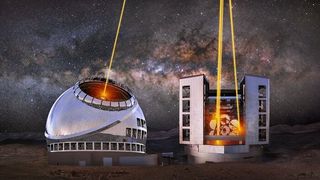
There's a bit of tension right now in the U.S. astronomy community and, perhaps unsurprisingly, it has to do with telescopes — extremely large telescopes, in fact. Here's what's going on.
The National Science Foundation (NSF), a source of public funding that two powerful next-gen observatories have been banking on for financial support, is facing pressure to go forward with only one telescope. This is because last month, the National Science Board — which is basically an advisory committee for the NSF — recommended that it cap its giant telescope budget at $1.6 billion. This is a lot of money, but it's just not enough for both. The board even says the NSF will have until only May of this year to decide which telescope gets the go-ahead.
Yet, both telescopes are already in the middle of construction, both are equally important and both are actually supposed to work together to fulfill a wide-eyed dream for astronomers. Because of how utterly huge they're meant to be, they're expected to one-up even the $10 billion James Webb Space Telescope (JWST) in many ways. That's the gold-mirrored, silvery-shielded trailblazer sitting a million miles from Earth right now, finding deep space gems so quickly it's normalizing us to seeing things humanity once couldn't fathom seeing. Imagine something better.
"To my knowledge, neither telescope today has a path forward without the investment by NSF," John O'Meara, chief scientist at the Keck Observatory, told Space.com. "I've said in other interviews that 'great vision should drive great budget, not vice versa,' and I believe it here."
One of the big scopes is the Giant Magellan Telescope (GMT). It's taking shape as you read this in the clear-skied deserts of Chile, and it's projected to cost something like $2.54 billion as a whole. The other is called The Thirty Meter Telescope (TMT). That one's location is a bit more controversial. It's planned to decorate a mountain in Hawaii called Mauna Kea, but locals have protested the decision because this stunning volcanic peak that boasts low humidity and gentle winds (perfect conditions for astronomy) is extremely meaningful in native Hawaiian culture. It's a fraught situation, as 13 other telescopes already live in the area and some local people say the facilities are impacting the natural environment. In terms of cost, however, the projected amount is just about symmetrical to the GMT's.
"They're expensive," Eric Isaacs, the president of the Carnegie Institution for Science, which has provided a sizable amount of private funding for the GMT, told Space.com "Not so much that the NSF couldn't do it — but they'd have to move things around and decide that's a priority."

An artist's illustration of the Thirty Meter Telescope atop the volcanic peak of Maunakea in Hawaii. (Image credit: Thirty Meter Telescope)
As of now, both telescope crews seem to remain hopeful while waiting for a decision.
"Our international consortium is fully committed to successfully completing the $2.54 billion Giant Magellan Telescope," the GMT team told Space.com.
"We read with great interest the NSB's recommendation to the NSF and are eager to work with the NSF to advance US leadership in astronomy for the next generation of astronomers," a spokesperson for the TMT told Space.com.
Isaacs acknowledges there's some natural competition due to the $1.6 billion announcement, but all in all, emphasizes that the teams have a united front. "We're sticking together," he said. "We were hoping NSF would come up with anything at this point, and they're really waking up to this."
Telescope friends
There's a key reason these telescopes are meant to be companions. Each can find the other's missing pieces; together, they can paint a picture of the universe in its grand totality.
The GMT is going to be on call for the Southern Hemisphere, while the TMT will have the Northern Hemisphere. Both also have complementary expertises. Some things the TMT can do, the GMT won't be as trained on. But the GMT can pick up where the TMT leaves off in other regards. Tag-team vibes. In this way, while holding hands and walking through the cosmos, the telescopes are supposed to be able to execute science our current robotic eyes on the sky simply can't compete with. How could a ground-based telescope view things the spaceborne JWST can't, you wonder? The quick answer is that a telescope on our planet can be bigger than one in space. For now, at least.

The TMT, which just finished polishing the 100th of its 492 total mirror segments, is planned to have a primary mirror that's (obviously) 30 meters, or 100 feet, in diameter. The GMT will have seven 27.6-foot-wide (8.4 m) mirror segments positioned in a pattern that resembles a six-petaled daisy to form a single 83.3-foot-wide (25.4 m) light-collecting surface. The bigger the mirror, the more light you can get. The more light you can get, the deeper you can see, and the dimmer objects you can pick up.
"TMT will deliver images that are more than 12 times sharper than the Hubble Space Telescope and more than four times sharper than those from JWST," the TMT team said in a release.
"These are the instruments for the next decades," Isaacs said.
Plus, both ground-based observatories can be adapted over time because they're physically on our planet. A bunch of astronauts can't exactly travel a million miles to reach Lagrange Point 2, where the JWST is situated, to tinker with the machine. The Hubble Space Telescope could be serviced back in the day because it sits in low Earth orbit — but even that was enough of a feat to warrant celebration decades later.
Why the U.S. government has a stake in the stars
It's fascinating how the science board's recommendation has sent ripples down into politics, managing to make headlines about the country's tricky status as a leader among the stars.
The worry comes from the fact that these telescopes are supposed to represent a significant leap forward for U.S. astronomy and U.S. astronomers.
Already, the European Southern Observatory's giant telescope project (unironically named the Extremely Large Telescope) is walking steadily to completion; China also has plans for its own enormous bridge to the stars.
"From our view, the most important thing is, let's at least build one," Isaacs said. "If we don't, we're out of the game, and China and the EU [European Union] are going to continue on. But we certainly want to advocate for two at this point, because we think it really keeps us in a leadership position."
In fact, soon after the board presented its $1.6 billion recommendation, Congress released its Fiscal Year 2024 funding bill. In this bill, Congress says it would like the nation to have a "two-observatory footprint" via the U.S. Extremely Large Telescope (USELT) program, though funding levels weren't specified. Interestingly, it does mention that the NSF, in total, will get $9.06 billion to work with. Still, the NSB's number remains the only one scientists have to contend with as of yet for the telescope program.
"I think that number, it sends a message," Isaacs said. "I mean, we have roughly a third of what we need, but we can't build it unless we get NSF involved because it's just going to be hard to raise that kind of money, even from wealthy, private people. It's the same thing with the TMT.
However, it's also worth considering, as Isaacs points out, that $1.6 billion isn't exactly an out-of-the-blue figure. "It wasn't a magic number," he said. "That was the number that was originally in the Astro 2020 report."
Which brings us to the next layer of complexity in the situation.
In short, Astro2020 refers to a super-detailed outline of what the nation's astronomy and astrophysics priorities should be during the 2020s. For this reason, it's also called the Decadal Survey. It's written by the National Academies of Science, Engineering and Medicine — but most importantly for this bit of astronomy drama, Astro2020 specifically advocated for at least one extremely large telescope, and "ideally" two: The GMT and the TMT.
"The Astro2020 report is not a mere suggestion," Isaacs said. "It's a very strong statement."
"The Decadal put forward a bold vision for what tools we need and the mandate that we build and use them responsibly," O'Meara said. "I think we can rise to that challenge and work with congress to fund USELT as a two-telescope project. Otherwise, U.S. leadership is at risk."
The slight contradiction, however, is that the report says the NSF should invest $1.8 billion in the project. This issue stems from the survey being a bit dated. It was released in 2021; since then, costs have risen.
"The next generation of telescope projects have gotten so huge and ambitious, and as a result they require an immense amount of coordination and planning," Dillon Brout, an assistant professor of astronomy and physics at Boston University, told Space.com. "While the announcement is indeed a tough pill to swallow, it's commendable that the NSF has made this decision sooner rather than later."
"It is an investment at a scale NSF is not used to for a facility, both in construction and in eventual operations," O'Meara said. "That said, the science demands these capabilities."
There is one aspect of the situation that, when we really sit back and consider it, may feel either humbling or frustrating, depending on your perspective. The NSF's money is public money, aka taxpayer money, aka our money.
The topic has therefore spurred a lot of interesting conversations in this vein. What does this conundrum say about how we fund scientific advancement? What does it say about anyone having an interest in science?
"We must use opportunities when astronomy funding is in the public discourse to reiterate how essential it is to continue to financially support these efforts that will unlock never-before-seen depths of our universe," Brout said. "This is especially true if the United States wants to maintain its position as a world leader in the fields of astronomy, astrophysics and cosmology."
Sometimes, Isaacs says, he'll sit down at a restaurant and wonder how people in the room would react if it were announced that scientists had found an alien.
"I look at the person next to me and say, 'How would you like it if I could tell you there was life on another planet?'" he recalled. "And half of them say, 'Oh, that'd be so cool.' And half of them say 'Why? Why would we spend money on that? We've got to care about our problems on Earth.'"
It's a fair question, and one that's been raised many times in the past. We see a version of it raised when it comes to NASA's modern Artemis moon missions, for instance, and it was absolutely raised during NASA's older Apollo lunar program. And we'll surely see it brought up many more times in the years to come.
But maybe science is worth it. Not just medical science and climate science due to the direct, tangible repercussions they have, but also star science, black hole science and dark energy science. The James Webb Space Telescope has undoubtedly helped humans across the world feel like they're under the same blanket of awe despite tragedy and war, and the first direct image of a black hole, captured a few years ago by the Event Horizon Telescope, was on the front page of every major news outlet for a reason. Space discoveries may not impact our bodies, but they surely impact our perspectives. Beyond that even, a few billion dollars for science advancement is meager compared to the huge sums of public funding allocated for things like defense, which receives many hundreds of billions year after year.
And, though NASA is working on building some relevant instruments for the planned big observatories, private funding right now is leading the charge. For some context, NASA's funding allotment in the FY2024 bill was set at $24.875 billion to "explore the solar system, understand climate change, promote innovation and sustainability in aeronautics, and protect our planet."
"When the opportunity arises to answer the toughest questions the universe can throw at us, astronomy has worked with Congress to fund those tools," O'Meara said. As he underlines, the Rubin Observatory, set to achieve first light in 2025, the Nancy Grace Roman Space Telescope, slated to launch to space in 2027, as well as the Daniel K. Inouye Solar Telescope and the JWST of course, already churning out results, are all examples of "going big because the questions are big."
"We should be doing that with USELT as well," he said.
Private funding has worked for other telescopes, such as with the Keck Observatory, but those projects weren't as big as this one. Keck's cost ran into the millions, not the billions.
— This new authority will decide the fate of astronomy atop Hawaii's contested Maunakea volcano
— Giant Magellan Telescope project casts 7th and final mirror
— The Magellanic Clouds must be renamed, astronomers say
"Once NSF says they're in, you're going to get everybody interested. Right now, we have 14 members of the consortium, which is a lot, but we are still looking for a way to make ends meet," Isaacs said.
So, where do we go from here?
Well, it seems like we'll know more in May, when the NSF tells us what they've been discussing behind the scenes. "NSF has to come in, or else it's going to be very hard," Isaacs said. You know, of course, we'll do other things with a lot of other great ideas in astronomy — but this is the big idea."
"I'd say astronomy is in a golden age right now," he remarked. "And, to give up on ground-based astronomy at this point would be the wrong time."
Update 3/10: In Eric Isaacs' third-to-last comment, he was referring to the NSF, not NASA. This article has been updated to reflect that.
Ground-based facilities enable the greatest scientific production in all of astronomy. The NSF needs to be ambitious, and it's now or never.
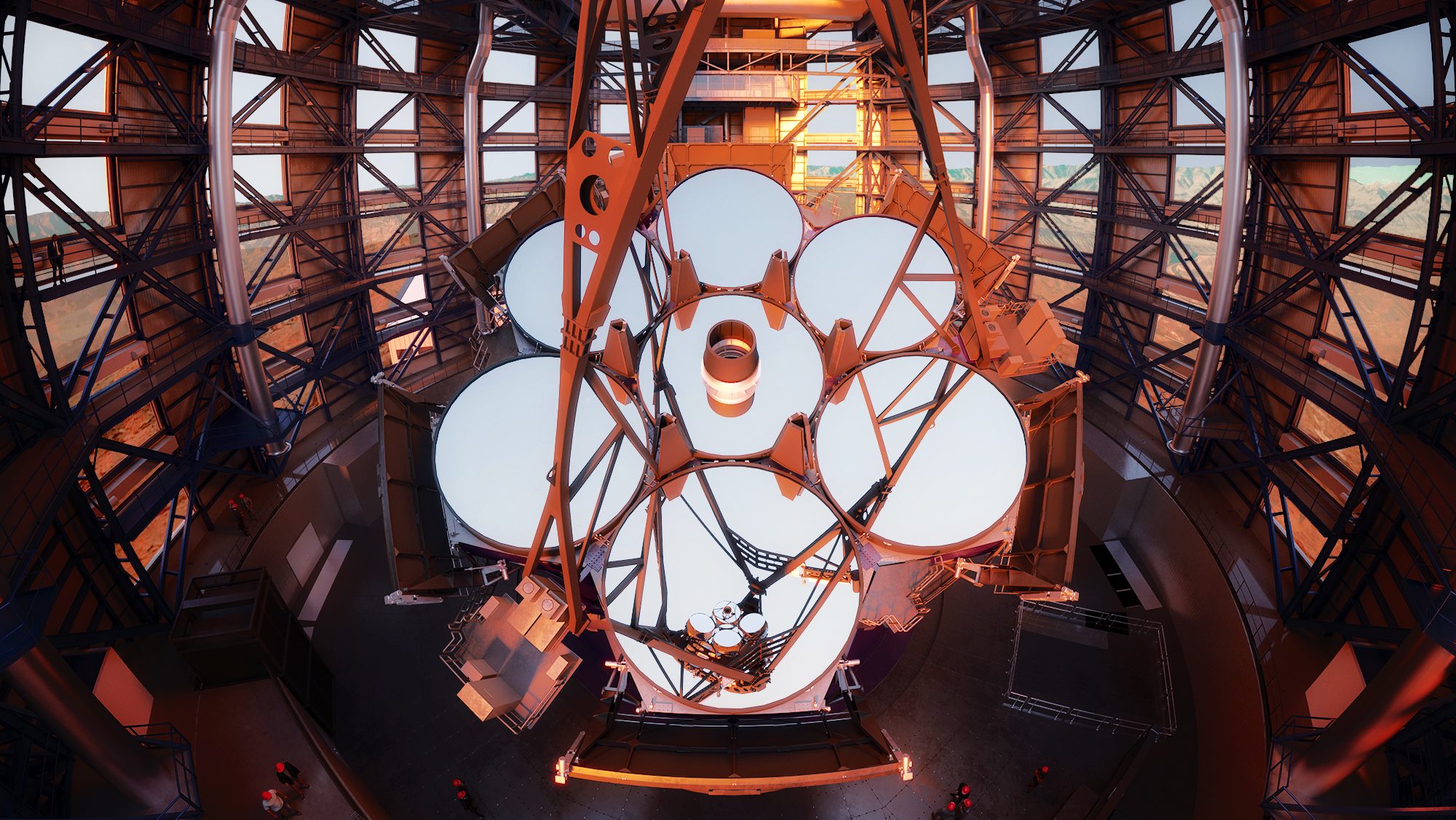
The 25-meter Giant Magellan Telescope is currently under construction, and will be the greatest new ground-based observatory on Earth. The spider arms, seen holding the secondary mirror in place, are specially designed so that their line-of-sight falls directly between the narrow gaps in the GMT mirrors, creating a view of the Universe without sharp corners to its mirrors or diffraction spikes around its stars. As one of the two US Extremely Large Telescopes proposed by astronomers and currently in development, it is an essential part of bringing about a new generation in cutting-edge ground-based astronomy facilities.
Credit: Giant Magellan Telescope/GMTO Corporation
KEY TAKEAWAYS
With three observatories planned: the European Extremely Large Telescope, the Giant Magellan Telescope, and the Thirty Meter Telescope, those science goals would be met, ensuring a bright future for astronomy.
In a shocking statement released in late February of 2024, however, the National Science Foundation recommended investing in only one new telescope: not two, as had always been planned. Here's why the investment is worth it.

Ethan Siegel
— MARCH 7, 2024
If you want to push the frontiers of science, you don’t just need brilliant minds with first-rate educations, you also need cutting-edge facilities to support them.
When it comes to the science of astronomy and astrophysics, the next generation of necessary facilities — in the ground and in space, across all wavelengths of light, and even extending beyond light to particles and gravitational waves — were just recently agreed-upon by the National Academies of Sciences in a decadal report known as Astro2020. With a truly balanced portfolio between: ground-based and space-based endeavors,small, medium, large, and flagship missions,various fields of astronomy, from within our Solar System to exoplanets to stars and galaxies to cosmology,and a series of new and upgraded facilities, including two extremely large telescopes, the next-generation Very Large Array, and upgrades to the IceCube facility for detecting neutrinos at the south pole,as well as investments in the next generation of scientists,
These recommendations were adopted, across-the-board, by federal agencies such as NASA and the Department of Energy, and were expected to be (but have not been, to date) adopted by the National Science Foundation as well. However, with one penny-pinching and short-sighted resolution, the NSF has decided that instead of building two extremely large telescopes, the United States will only contribute towards one, and even that is only to the tune of a maximum of $1.6 billion, as recommended by the National Science Board. The truth is we need these facilities, as many have argued, and perhaps the best way to understand why is to debunk the most common myths associated with arguing why we don’t.

This artist’s rendering shows a night view of the Extremely Large Telescope in operation on Cerro Armazones in northern Chile. The telescope is shown using lasers to create artificial stars high in the atmosphere. The use of artificial guide stars, which reflect off of the atmosphere’s sodium layer 60 km up, are tremendously useful for the implementation of adaptive optics, and can allow ground-based telescopes to compete with or even outcompete smaller space-based telescopes that are above Earth’s atmosphere entirely across a variety of metrics.Credit: ESO/L. Calçada
1.) All the best astronomy is now done from space. It’s true that our space-based observatories, including Hubble and the JWST, have made and continue to make discoveries that no ground-based facility can match. However, around 90% of all scientific proposals to use those facilities are rejected for one very non-scientific reason: they’re oversubscribed. There are too many scientists with too many good ideas for doing science for most proposals to get accepted. In other words, there are too many things to learn, and too many good science cases, for the expensive space-based observatories to do it all.
Instead, space-based and ground-based facilities work best together: with space-based facilities usually ideal for discovery and ground-based facilities preferred for follow-up and further investigation.
The five major arenas where ground-based facilities are superior to space-based facilities are:size, as building as large and as heavy as you like is no obstacle to ground-based construction,reliability, as there are no launch costs or risk of launch failure,versatility, as each individual ground-based facility provides a unique set of locations and opportunities for observing unique or one-time events,maintenance, as there’s plenty of ground-based infrastructure (and no space-based infrastructure) for repairing, servicing, and replacing worn-out components on these observatories, and upgradeability, as old instruments are easily swapped out on the ground for newly-built ones, unlike in space, where it can only be done with great investments of money and labor.
The instruments aboard Hubble and JWST will be the same in 10 or 20 years as they are today, while ground-based telescopes only continue to improve with minimal further investment

This multi-paneled image shows the details returned by each of the JWST’s instruments in the same pointing/field-of-view during its commissioning in the first half of 2022. For the first time, in late April of 2022, all of the instruments across the full field-of-view were properly and fully calibrated, bringing JWST one step closer to being ready to begin science operations. Although JWST and its instruments give us a truly world-class space-based observatory, this technology is “frozen in,” and cannot have its instruments upgraded the way we can upgrade instruments easily and cheaply on ground-based telescopes.
2.) Philanthropic contributions should be enough to support astronomy. It’s true that both of the proposed US extremely large telescopes, the Giant Magellan Telescope (GMT) and the Thirty Meter Telescope (TMT), have assembled an impressive series of funding partners from across the world, from both private foundations and commitments from other governments and public institutes. GMT, for example, boasts funding from Taiwan, Australia, Brazil, Chile, Israel, South Korea, and the United States, and has already fabricated each and every one of its giant, 8.4-meter diameter primary mirror segments that will compose the eventual 25.4-meter diameter assembled mirror for observing the Universe.
TMT, meanwhile, is supported by India, Japan, and Canada, as well as AURA (the Association of Universities for Research in Astronomy) and the Moore foundation, and the TMT International Observatory has just produced the 100th polished mirror segment of an eventual 492, required to compose the 30-meter diameter primary mirror. This is an enormous amount of support, but public funding — especially for staffing and the maintenance of the observing facilities — is also required. Without the support of the National Science Foundation, ground-based astronomy as we know it, including last generation’s flagship ground-based observatories like:the Keck telescopes,
the Very Large Array, the IceCube Neutrino Observatory, and LIGO, all would have been impossible.
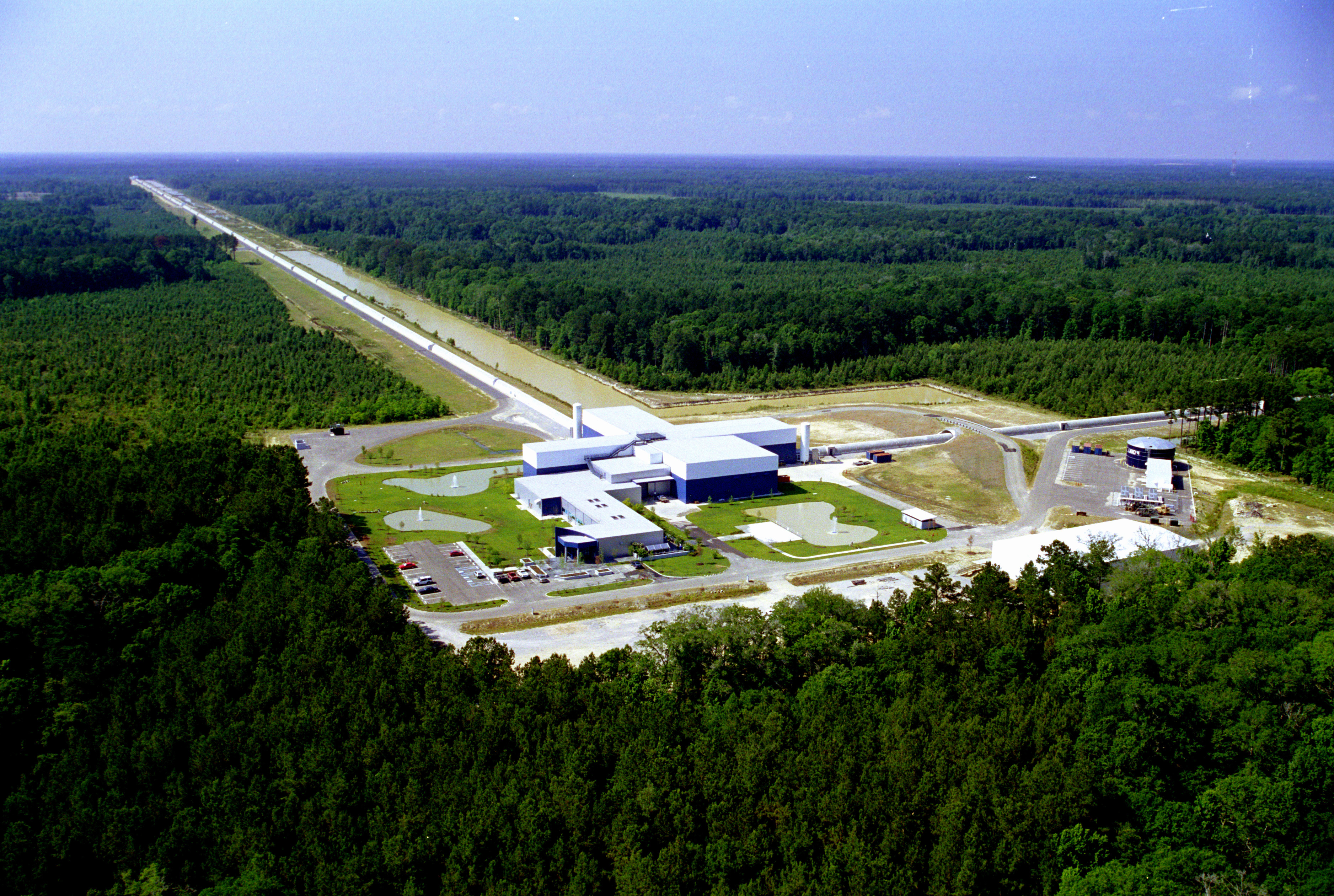
This aerial view shows the main science hub of the LIGO Livingston detector in Louisiana, with a view peering all the way down one of its 4 km long detector arms. Complemented by LIGO Hanford in eastern Washington, these two detectors not only brought us our first gravitational wave detection, but have netted more gravitational wave discoveries than all other efforts combined. Without investments in cutting edge facilities such as this, our ground-based astronomy efforts, from light to gravitational waves to particles like neutrinos, would still be in their infancy.
3.) One US-based giant telescope can do all the science that two can do, it just takes more time. Whenever and wherever you are on Earth, every time you look up at the night sky, you’re only seeing half of what there is to observe. Even if each and every night were clear and cloud-free, and you observed the sky every night throughout the entire year as Earth revolves around the Sun, you wouldn’t manage to cover the whole sky. That’s because from our perspective on planet Earth, every location can only see:the entire half of the celestial hemisphere that corresponds to their latitude (north or south),
and the portion of the opposite celestial hemisphere that extends down to 90° minus their actual latitude.
Furthermore, the best observing always occurs close to overhead, rather than near the horizon, so if you have a telescope in the northern hemisphere, it’s impossible to look at objects with deep southern latitudes, and if you have one in the southern hemisphere, objects too far north will be unobservable. If you’re right at the equator, viewing near either pole will be a challenge as well. Also, for the purposes of “targets of opportunity,” which is what astronomers do when they observe transient objects, you need to be able to view the needed target at the critical moment, which is usually as quickly as possible. For flexibility, you want telescopes at various longitudes, so it’s always night when some powerful telescope can access the skies. Fewer telescopes means more missed opportunities and more missed objects.
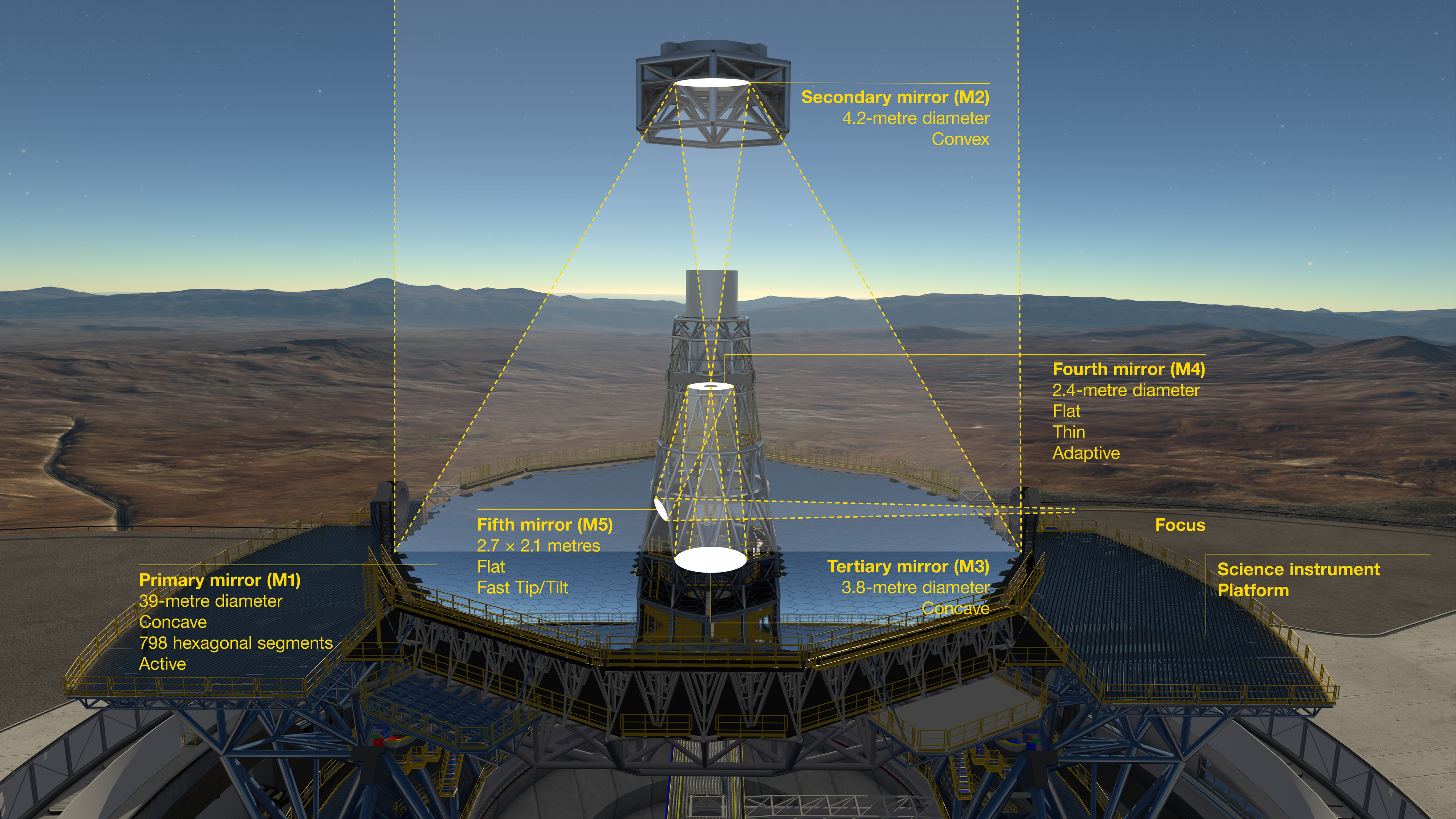
This diagram shows the novel 5-mirror optical system of ESO’s Extremely Large Telescope (ELT). Before reaching the science instruments the light is first reflected from the telescope’s giant concave 39-meter segmented primary mirror (M1), it then bounces off two further 4-meter-class mirrors, one convex (M2) and one concave (M3). The final two mirrors (M4 and M5) form a built-in adaptive optics system to allow extremely sharp images to be formed at the final focal plane. The primary mirror consists of 798 segments to form the 39-meter mirror, but the light that matters isn’t the light that’s collected, but rather the light that reaches the instruments.
4.) The European Extremely Large Telescope, at 39 meters in diameter, is superior to the smaller US-based ones anyway. It’s difficult to emphasize just how wrongheaded this line of thought is. Here on Earth, there are around 15 optical telescopes of the current flagship class: with primary mirrors between 6.5 meters and 11 meters in diameter. All built during the decades of the 1990s and 2000s, the overwhelming majority of them are located in the three best physical locations on Earth for ground-based optical astronomy. In order, from best to third best, they are:the summit of Mauna Kea in Hawaii, the top of the Chilean Andes mountain range, and the summit of the island of La Palma, in the Canary Islands in Spain.
These are the locations that have the combination of the highest altitudes, stillest, lowest-humidity air, the least amount of turbulence, the lowest chances of cloud cover, and are closest to equatorial latitudes.
You might think that the largest telescopes in the best locations, like the Gran Telescopio Canarias and the Keck 1 and 2 telescopes, would be the most scientifically productive and prolific telescopes year after year, but that simply isn’t true. Every one of the telescopes that are 6.5 meters in diameter or larger at any of the above three mentioned locations are all comparably scientifically productive to one another, with similar numbers of scientific papers, similar scientific impacts, and similar numbers of major discoveries coming from each of them. Having more telescopes allows you to design more specialized instruments for them, enabling a broader array of science, from infrared observing to spectroscopy to coronagraphy to planet imaging and more. The jump from one size class to another is huge; the minor differences between the sizes of telescopes in the same class is far smaller than the differences in instrumentation.

The three largest telescopes in this image, located along the right, are the TMT, ELT, and GMT, and represent a new 30 meter class, from 25.4 to 39 meters in diameter. For comparison, today’s cutting-edge modern day telescopes range from 6.5 to 11.0 meters in diameter, and are represented by the majority of ground-based telescopes shown in the two middle columns. The leap from the current to the next generation will be transformative.
5.) Upgradeability is a major factor, as well as an underappreciated factor, in the sustained productivity of a telescope. How long does it take to build an instrument for a telescope, and how expensive does that instrument wind up being? If you look at the last 20 years of astronomy’s history, you’ll find that the biggest determining factor, on both accounts, is the size of the instrument. While the European Extremely Large Telescope (ELT) might have a 39 meter primary mirror and the Giant Magellan Telescope (GMT) may only have a 25 meter primary mirror, the size of the first-generation instruments aboard the ELT are planned to be a whopping thirty times the volume, each, of the first-generation instruments that have been planned and designed for GMT.
Costs scale with size, and although the ELT is promising a completion date of 2028, their instruments have not even reached final design, making that a dubious goal in the eyes of most astronomers who are instrument specialists. Additionally, the more reflections your optical system requires and the more upward-facing mirrors that system possesses, the more light you lose before it ever arrives in the instruments. The ELT has three up-facing mirrors and requires a total of four reflections before light reaches the instruments, whereas the GMT has only one up-facing mirror and requires only one reflection (for two instruments; two other instruments need a second reflection) before light reaches the instruments.
The ELT might be the “Cadillac” of 30-meter class telescopes, but for a wide variety of applications — including coronagraphy, planet imaging, and building the second generation of instruments down the road — the “Honda” that is the GMT or the “Subaru” that is the TMT will be the superior choice.
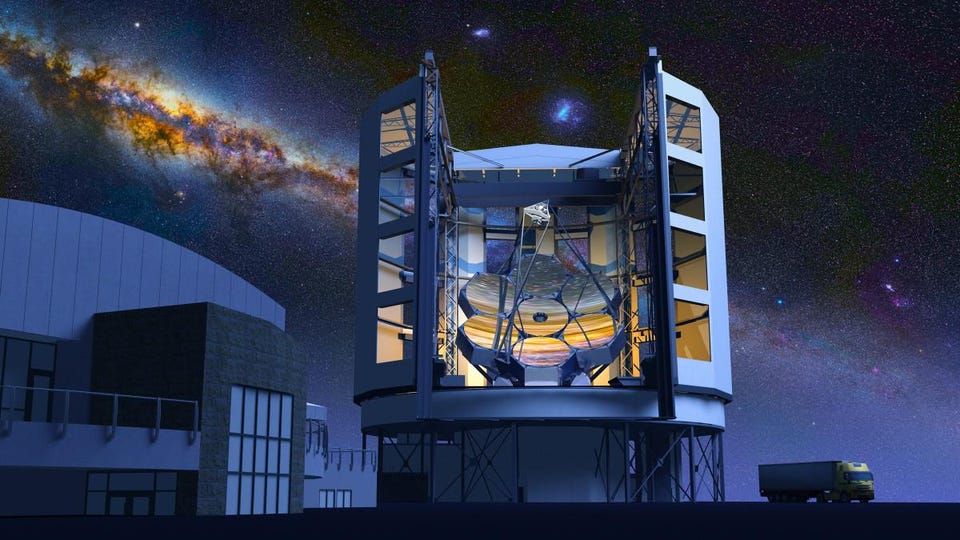
The Giant Magellan Telescope is already well under construction, and should reach completion by the decade’s end. At 25 meters in diameter, it will be either the largest or second-largest telescope in the world upon completion, depending only on whether the 39 meter diameter E-ELT is completed first.
6.) The tensions between astronomers and native Hawaiians means that the Thirty Meter Telescope (TMT) can never happen anyway. This might have been a defensible position five years ago, but changes in TMT leadership, the government in Hawaii, and the stewardship plan and process for Mauna Kea have paved a path forward that is incredibly encouraging. The total number of telescopes on Mauna Kea is presently being reduced but not eliminated, and a scientifically productive future for astronomy is currently being planned and negotiated right now. While it is still being decided which telescopes will remain, which old ones will be decommissioned, and which new ones will be built, there is a future for TMT regardless of what decisions are made.
If there is a suitable site atop Mauna Kea where all parties agree the TMT should be built, then that will be the location of the northern hemisphere’s premiere and only 30 meter-class telescope. If not, La Palma in Spain has offered to provide the land and host the TMT as a backup location, which would then be where the northern hemisphere’s premiere and only 30 meter-class telescope would be located. There are options for where it can be built and — realistically — where it can serve the needs of the astronomical community for the next 30 to 50 years. There is a path forward for both astronomy and native Hawaiians to work fruitfully together on Mauna Kea, and for the TMT to exist as either part of that collaboration or as external to that endeavor.
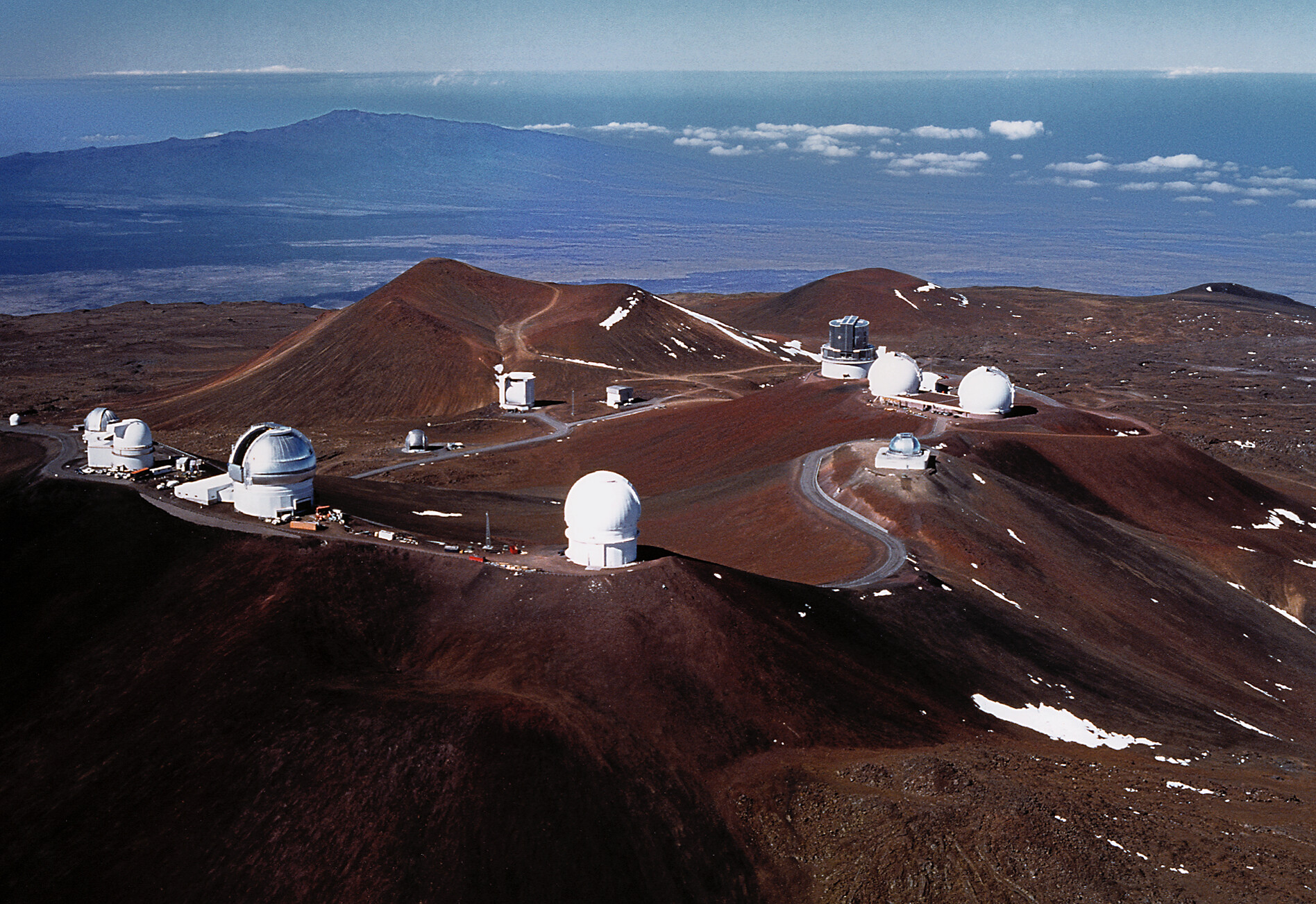
This aerial view shows the summit of Mauna Kea with a series of astronomical observatories and roads connecting them to one another and to the Mauna Kea access road. These observatories, on one of the most sacred locations in Hawaiian society and culture, should not continue to exist as a legacy of an unethical past, but can only continue to exist with the consent of the native population.Credit: Richard Wainscoat/International Gemini Observatory/AURA/NSF
7.) Nothing would be lost by deciding not to build one of these telescopes at this point in time. Once you stop investing in something important to your nation, that field almost never recovers in that country. In the late 1980s and early 1990s, particle physicists around the world had set the highest priorities for their field as being a next-generation collider capable of reaching higher energies and greater numbers of collisions than ever before, and the United States was going to lead the way: by building the SSC: the Superconducting Super-Collider. It’s now around 30 years since that project was killed, and if you look at the priorities of the United States particle physics community today, you’ll see that the United States is playing only a complementary, supporting role when it comes to cutting-edge particle physics. There are no particle colliders or particle accelerators at the frontiers in this country any more.
If we abdicate leadership in astronomy and astrophysics today, and abandon the commitment to cutting-edge ground-based facilities that quite literally have brought us an understanding of the Universe, from the nature of galaxies to cosmic expansion to the Big Bang to the discoveries of dark matter and dark energy, we would be choosing to sunset our status as the scientific leader in the world of astronomy and astrophysics. Deciding to only build one extremely large telescope would signal to one of those two collaborations — either the GMT or the TMT — that all of the efforts, money, and time put into that project, including the millions of worker-hours and the commitments and investments of hundreds of millions of dollars, were wasted, because the United States itself, through the National Science Foundation, is unreliable as a funding partner.
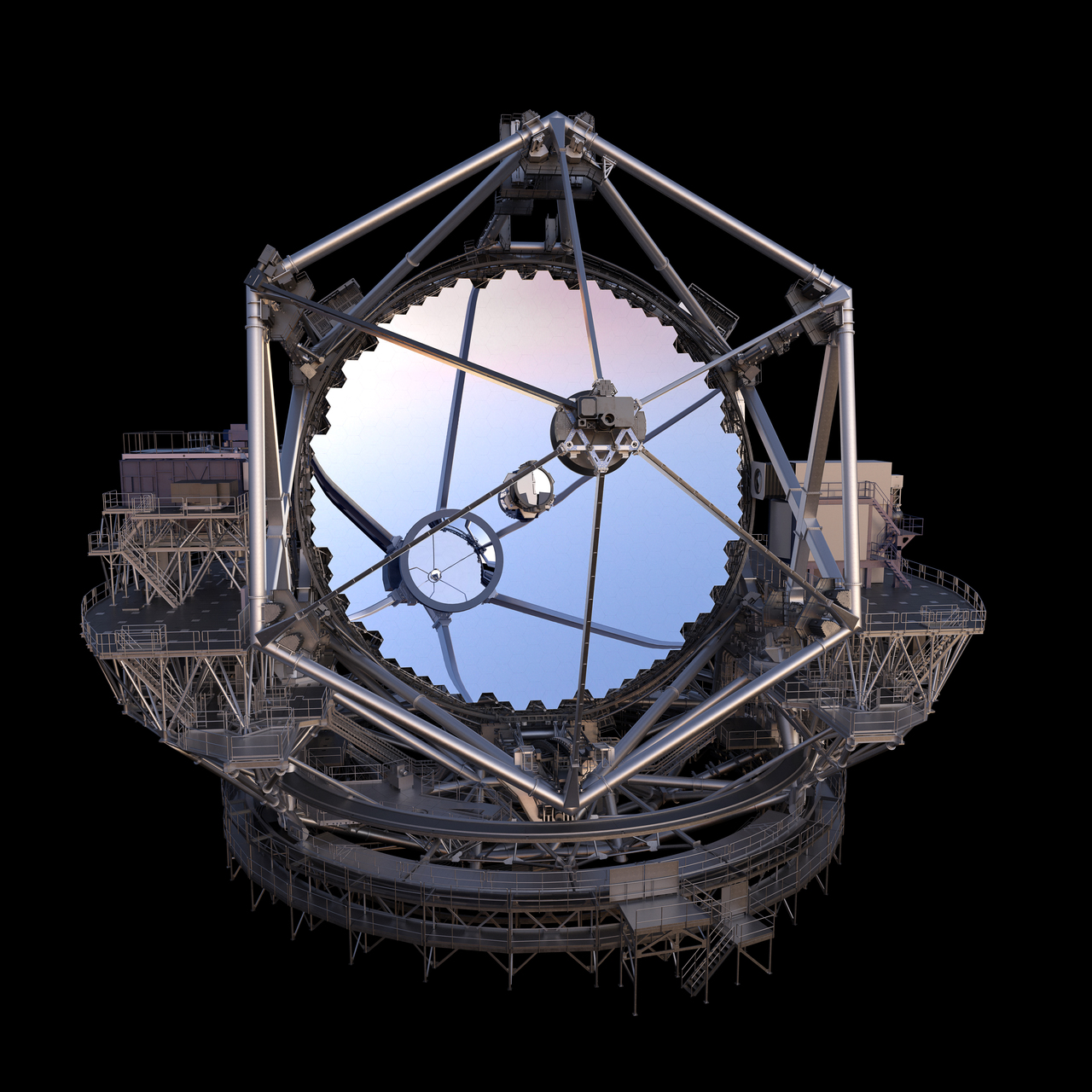
The Thirty Meter Telescope is shown at a very low elevation angle in this digital rendering. The segmented primary mirror reflects the convex secondary mirror. The tertiary mirror in the center of the primary mirror is oriented to send light to the Wide Field Optical Spectrograph, the gray structure located on the right side of the image: one of the observatory’s main instruments. The left and right instrument platforms are seen and the dark blue adaptive optics enclosure is seen on the upper left on the instrument support structure.Credit: TMT International Observatory
8.) This decision will save money, in both the long and short runs, for the country. Financial austerity, when it comes to being truly fiscally responsible, should absolutely never be applied to basic research the way it is to other areas of government spending. The entirety of the National Science Foundation’s budget has never once totaled more than 0.05% of Gross Domestic Product or more than $10 billion in any fiscal year, and yet has spawned multiple companies whose net worth exceeds $100 billion. According to:the Center for American Progress,
the National Institute of Standards and Technology,
and even the National Science Foundation itself,
every dollar invested in science through the NSF, NASA, and DARPA, generates more than 100% of that investment in American economic activity: a positive return-on-investment. That means that not investing those dollars in basic research hurts the American economy by a greater amount than the cost of making the investment. As the former direction of the NSF, France Córdova, wrote in 2018:
“Scientific breakthroughs start with a question, a big idea, about the nature of things that often leads to a fundamental shift in thinking. The ability to pursue and investigate that question, and to innovate along the way, is what enables the discoveries that ultimately transform the world.”
If we don’t invest in asking and answering those questions, that’s the same as choosing to remain exactly where we are instead of furthering our path down the roads of progress
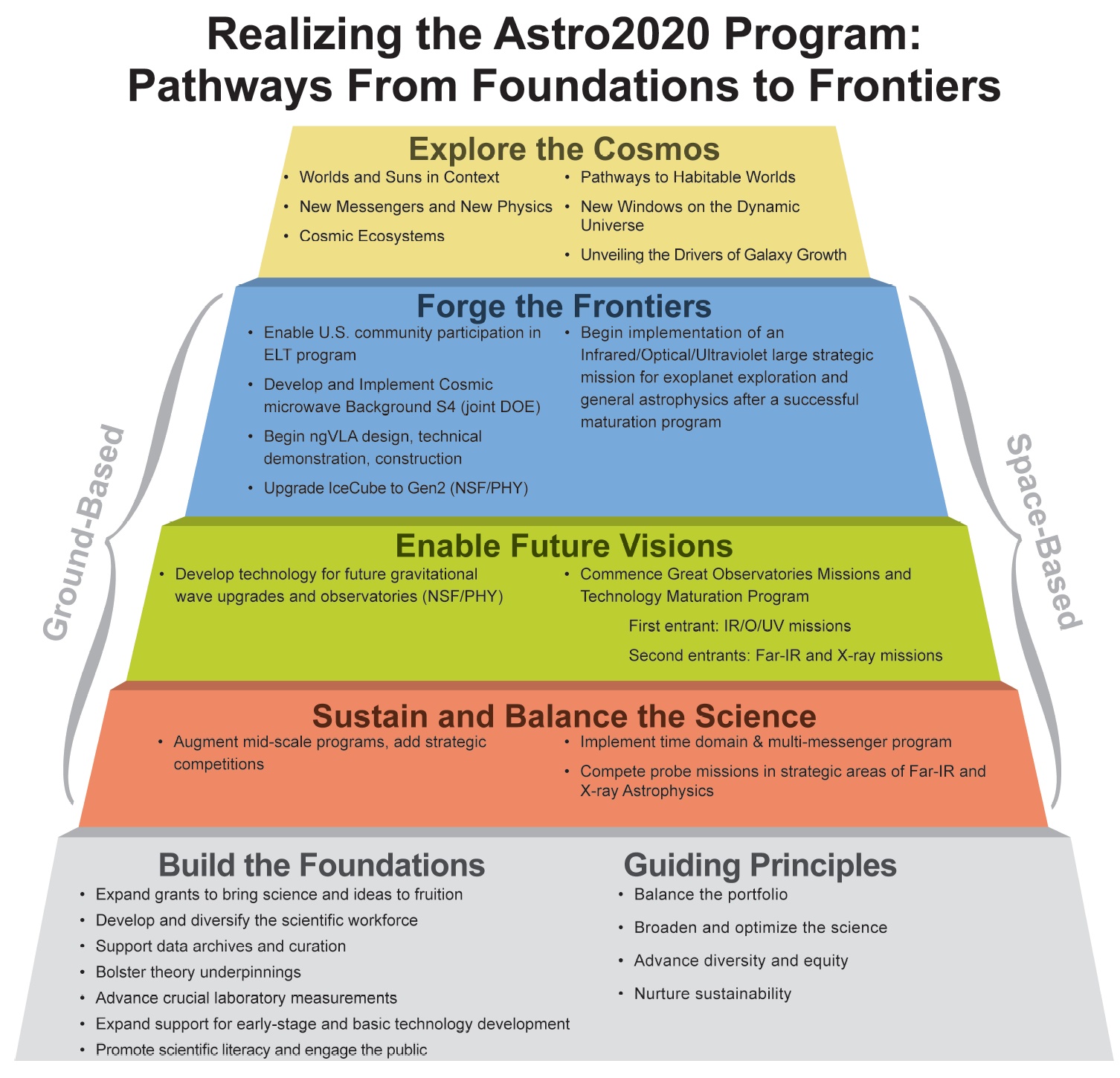
The various plans and initiatives from the Astro2020 decadal survey touch on a wide variety of initiatives and pathways, ensuring a successful long-term and short-term future for astronomy and astrophysics if we choose to follow this roadmap. If we choose instead to abandon it, that progress will not occur in the United States.
The reality is that, when political whims supersede the actual facts about investing our dollars into something worthwhile — even if making that investment would be a victory for our nation all-around — it’s a signpost of an empire not only in decline, but in the process of crumbling. There are many among us, maybe even the majority of us, who are simply not ready to accept that fate for our nation and for the fate of science within our nation, and the act of looking to the Universe itself for answers about the biggest questions of all is perhaps the most ambitious act of fundamental research we can engage in.
Questions such as:are we alone in the Universe, if there are inhabited worlds out there, what are they like, where did our solar system and planet come from, how did life arise on Earth, where did the Milky Way and the entire Universe come from, and what is the cosmic story that allowed us to come into existence, are not just questions for a privileged set of a few thousand researchers to investigate, but questions fundamental to all of humanity whose answers lie within our reach, if only we dare to look beyond the few fractions-of-a-percent of the cost of investing in finding out those answers. The scientists laid out the case for the path forward for the fields of astronomy and astrophysics in 2021 for the next decade, and all the major federal agencies except for the National Science Foundation have adopted what they recommended. If we want a future where the United States of America remains on the cutting edge of science, we’ll change course and make the investment we need to bring about a better tomorrow. And if not, we’ll meet with the same fate as every country that’s chosen cowardice when it comes to making those critical investments: stagnation and decline.
